#The Haunting of bly manor episode 6 the jolly corner
Text
The Haunting of Bly Manor (2020)
Episode length: 46-66 min.
Country: USA
Genre: Horror, Drama, Mystery
Language: English
A young governess is hired by a man to look after his niece and nephew at their family country house after they fall into his care. Soon after arriving at the Bly estate, she begins to experience strange occurrences and a grim history starts to unravel.
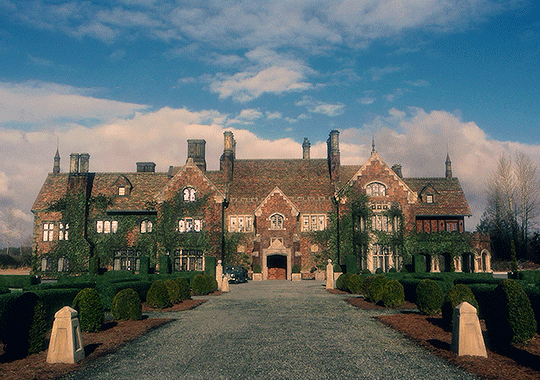
Season 1
Episode 1: The Great Good Place
Episode 2: The Pupil
Episode 3: The Two Faces, Part One
Episode 4: The Way It Came
Episode 5: The Altar of the Dead
Episode 6: The Jolly Corner
Episode 7: The Two Faces, Part Two
Episode 8: The Romance of Certain Old Clothes
Episode 9: The Beast in the Jungle
Watch on Netflix
2 notes
·
View notes
Photo
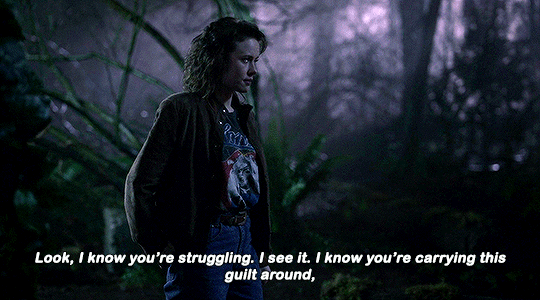







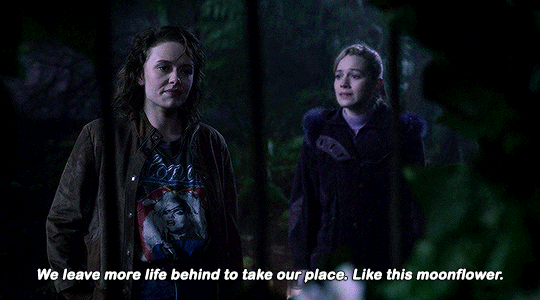
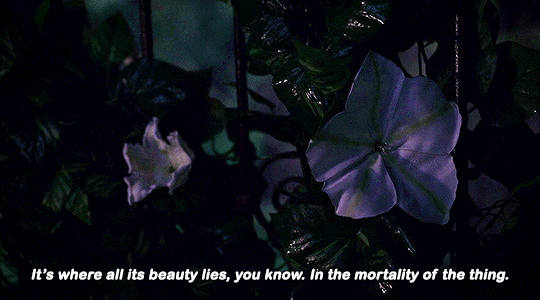
THE HAUNTING OF BLY MANOR
Episode 6: The Jolly Corner
#the haunting of bly manor#bm spoilers#2x06#dani clayton#jamie#thobmedit#*gifs#bbelcher#filmtv#cinemapix#userstream#userfreja#tusermadison#nessa007#tuserdee#tuserlo#by dana#request
3K notes
·
View notes
Photo

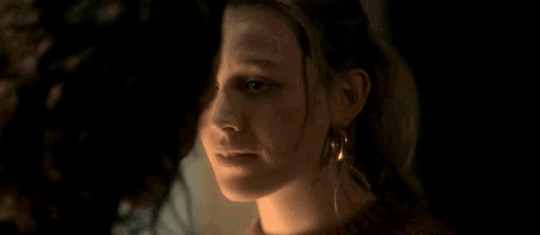

The Haunting of Bly Manor
Season 1, Episode 6 (The Jolly Corner)
#dani x jamie#jamie x dani#dani clayton#victoria pedretti#lesbian#lgbt#lgbtq#queer#sapphic#wlw#bly manor#bly manor edit#the haunting of bly manor#jamie and dani#dani and jamie#amelia eve#lesbian kiss#sapphic kiss
720 notes
·
View notes
Text
The Haunting of Bly Manor: Episode Analysis
Episode 8 - The Romance of Certain Old Clothes

Episode 8 is the penultimate episode of The Haunting of Bly Manor. This episode, as well as Episode 5, are some of the absolute standout episodes of the season and in this one we are given the origin story of who The Lady of the Lake was.
We find out that “towards the middle of the 17th century” the current owner of Bly Manor at that time had died, and he left his two daughters as his heirs to the estate. His daughters were Viola and Perdita, and Perdita was five years younger than her sister. It’s an interesting detail that in Latin, ‘perdita’ means ruined, wasted or lost. In accordance with the meaning of her name, Perdita’s life is completely wasted and lost to Viola.
In life - Perdita lost her husband to Viola (Arthur was first interested in her but Viola presented herself as the lady of the manor so that he would marry her instead), she lost most of her life to caring for Viola when she became sick with “the lung” and she literally lost her life to Viola when Viola strangled her.
In death - Perdita gets lost as a ghost when her face and memories all fade.

An amazing detail; is that when Viola and Perdita are mingling with the various suitors, no one in this scene actually opens their mouth when it looks like they’re speaking to another person. Everyone makes the physical gestures towards one another which you make when you speak to someone (like one person leaning in to be heard and the other leaning in to listen), but no one’s mouth actually opens in speech. This small detail, as well as the whole episode being in black and white, helps to immerse us into the fairytale or gothic romance-like tone of the episode.
After Viola marries Arthur, they have a child together. We discover that the origin of the phrase “it is you, it is me, it is us”, which is used to invite a ghost into a person, was first said by Viola to her baby daughter.


It’s not made completely clear, but it’s straight after Viola notices Perdita and Arthur looking at one another that “her suspicion began as small”, but also when “the tickle in her lungs” began. This may just be a coincidence, but if it’s not, then it’s strongly suggested to us that Viola’s illness stemmed from the jealousy and suspicion that planted itself within her - like an almost ‘Dorian Grey-style’ physical manifestation of the jealousy that infected her heart.
When the doctor’s treatments for Viola’s illness don’t work and her condition starts to look more terminal, Arthur calls the vicar to her bedside to preform an absolution rite. Out of sheer stubborn wilfulness Viola refuses to repeat the rites, saying to the vicar for him to “tell your god, that I do not go”. Arthur tries to covnince her to repeat the rites by telling her “it is not about your body any longer, my love. It is your soul we must treat. It is your soul I worry for”. Again it’s not made explicitly clear, but it’s strongly suggested that Viola doesn’t die peacefullly and her soul is imprisoned in the chest of clothes because she didn’t say the rites and so her soul was not properly treated before dying.
As Older Jamie is telling the story, she says that “then five times around the sun, and all is different”, as this was when Viola found Perdita dancing with Arthur and started to treat Perdita awfully. In Episode 9 Older Jamie also says that “five years would pass, and there was peace” for her and Dani, before Viola started to take over Dani’s body. It seems that Viola was given “five times around the sun” before she started to see the connection between Perdita and Arthur growing stronger and when all became different; and so Dani and Jamie were given “five years” of peace before Viola reared her head and made everything different for them.
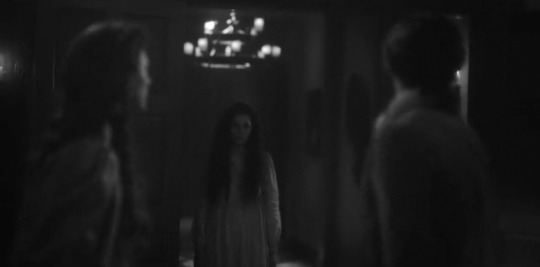
We also see a similarity being drawn between Viola and Peter. Viola is still hanging onto her life and refusing to die and Perdita says to her that “you should think of her, Vi. Think of Isabel. What will she be left with, what memories of you will she carry? Will it be this? This version of you? Because Viola, with love, let it be anything else”. It’s clear that Viola obviously does love her daughter but at the same time, by refusing to let go, she’s acting somewhat selfishly. Perdita is right when she says that Isabel will not carry any fond memories of her mother, but only a vision of her slowly wasting away in a “living death”. In the same way, Peter does love Rebecca but his decision to drown her was a completely selfish one, only thinking about his own loneliness and what he wanted.

We then see that Viola’s soul has been trapped in the chest which she locked her clothes in. While trapped in the chest she repeats a constant cycle of “sleeping, waking, walking” as she waits to see her daughter who will open the chest when she is of age. However when Perdita is the one who opens Viola’s chest, Viola strangles her as revenge for being killed by her and for her opening the chest that was supposed to be guarded until Isabel could open it. When Viola sees Arthur’s reaction to finding Perdita’s dead body, she doesn’t see “the changes wrought of time” but she sees “only his sadness”. This is heartbreaking for Viola, to see the man who was once her husband lamenting the loss of her sister.

Thinking that Viola’s chest was cursed, Arthur throws it into the lake so that Isabel would not succumb to the same curse that killed Perdita. It is this “absolute abandonment”, this “final insult”, which breaks Viola’s heart completely, and it’s from the anguish she feels and “stubbornness alone” which stops her “being pulled towards some other place, some realm beyond”. This stubbornness that Viola had, and because she ignored the pull from the “realm beyond”, meant that “she instead made her own gravity, gravity of will”.
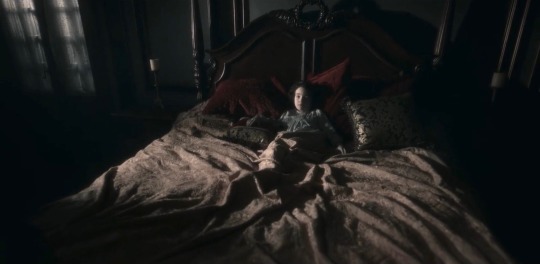
We find out that The Lady of the Lake’s journey through Bly Manor started when her chest was thrown into the lake. The trip that Viola makes is in the hope that she would one day find her daughter. She walks to her old bedroom in the hope that she will find her daughter but then when she doesn’t find her, she remembers that she died and that her daughter had left her. This remembering would break her heart after every single trip, and so she would sleep to forget what had happened and then would wake back up having forgotten. It is also revealed to us that most of the other ghosts which we see in the manor are people who got in the way of her path, the most tragic of whom was the Doll Face Ghost, who was a little boy that she mistook for her daughter and drowned.
Through this we are also presented the idea of the danger of becoming blindsided by anguish and stubbornness. Viola began her journey through the manor with the purpose of finding her daughter, but then as time went on and she forgot more and more, the journey just started to become a ritual, something repeatedly done mindlessly and with no purpose. Through this repeated ritual, she completely loses the purpose for which she once did this, and as a result takes the life of an innocent boy because she could only remember that she was searching for a child and so she thought that this must be the child whom she sought. Viola allows anger and grief from love to seethe inside her, and eventually it takes over her completely, leaving only that anger in control of the shell of her body.

As well as this, we find out that the reason that all the ghosts have lost their faces is due to a side effect of forgetting. As each of the ghosts gradually forget who they once were, this gets physically shown on their face. It is a visual representation of memories fading as the details slowly get lost and then they are eventually lost completely.
You can read my previous The Haunting of Bly Manor posts here:-
Episode 1 - The Great Good Place
Episode 2 - The Pupil
Episode 3 - The Two Faces, Part One
Episode 4 - The Way It Came
Episode 5 - The Altar of the Dead
Episode 6 - The Jolly Corner
Episode 7 - The Two Faces, Part Two
——————————————————————————
#the haunting of Bly manor#mike flanagan#victoria pedretti#oliver jackson cohen#Amelia eve#t’nia miller#rahul kohli#carla gugino#tahirah sharif#henry thomas#kate siegal#the haunting of hill house#dani x jamie#film#good tv#lgbtq#wlw#tv recommendations#tv reviews#horror#cinematography#dani clayton#thobm#thohh#thobm Netflix#thobmedit#peter x Rebecca#hannah x owen#you netflix#long reads
108 notes
·
View notes
Photo

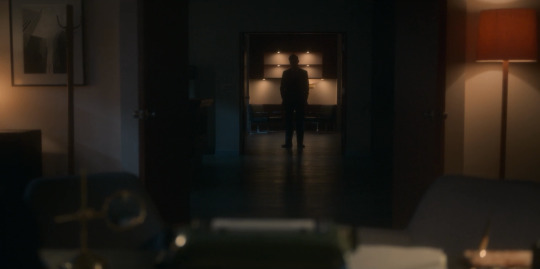
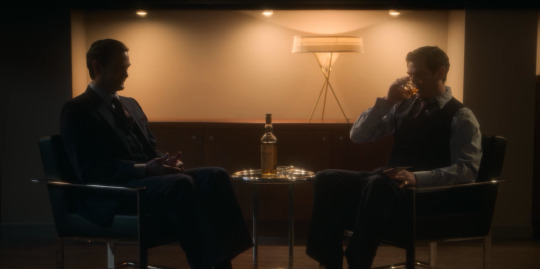
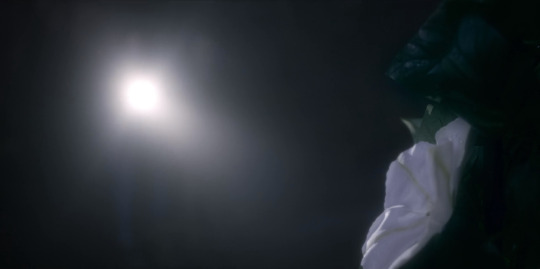
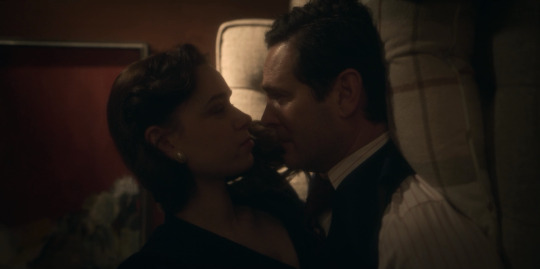


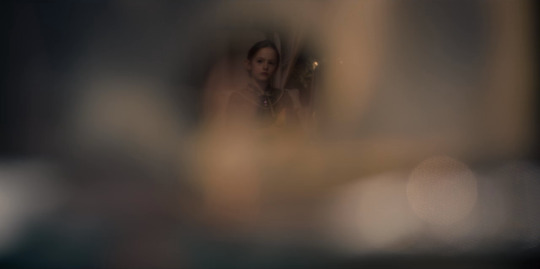


**Shots of the Episode**
The Haunting of Bly Manor (2020)
Episode 6: “The Jolly Corner” (2020)
Directors: Ben Howling & Yolanda Ramke
Cinematographer: James Kniest
#shots of the episode#the haunting of bly manor#haunting of bly manor#mike flanagan#the jolly corner#henry james#ben howling#yolanda ramke#james kniest#henry thomas#amelie bea smith#alex essoe#screencaps#screenshots#stills#tv stills#tv screencaps#tv screenshots#tv#streaming#netflix#horror#ghosts#ghost story#2020 tv#2020s tv#2020 in tv#2020#2.00:1
28 notes
·
View notes
Text
Why The Haunting of Bly Manor Needed a British Script Editor
https://ift.tt/eA8V8J
Warning: contains a spoiler for The Haunting of Bly Manor episode 6
When you belong to a cultural superpower, you get used to things being all about you. Wrapped in the soft cotton wool of cultural dominance, you so rarely feel the prick of non-recognition. To grow up the same nationality, race, and on the same patch of land as the planet’s most celebrated writers, artists and musicians is to feel that their stuff is yours too. Unlike other groups, there’s no fight for representation on your hands. The world literally speaks your language. Fiction is your comfort zone.
The extreme and enduring comfort of which must explain why the slightest jolt feels so unacceptable. The British like to think of ourselves as a solid, unflappable people, but really, we’re all paper doilies who tear at the slightest violation. And the worst violation we can suffer is at the hands of Americans who get Britishness wrong.
The Haunting of Bly Manor, Netflix’s new spooky series based on the works of Henry James – an American who elected late in life to become a British citizen, so technically a win for our team – is well aware of British indignation. In episode one, there’s a gag in which a Yank does a comically bad English accent and receives an eye-rolling response from a Brit (not an actual one, but Henry Thomas doing a sort of James Mason), and a running joke about said American’s inability to make tea (she approaches it more or less like the woman in this video with the added injury of using a coffee pot).
Trained in decades of King Ralph-style culture-clash jokes about the snooty British tutting at graceless Americans (see Downton Abbey, The Fresh Prince of Bel Air, Buffy the Vampire Slayer…), The Haunting of Bly Manor knows the routine: Brits get uppity about this stuff.
Why then, does the show go on to commit the most egregious offence of all by making English characters speak American? Only the US pronunciation of ‘twat’ as ‘twot’ is as likely to put an end to the Special Relationship and get everybody dusting off their Revolutionary War muskets as hearing a so-called Englishman saying “math” without an “s” at the end.
(Sidenote: as a young English child with weekly access to 1980s US sitcom Kate & Allie, I envied nothing more than the brown paper grocery bags and sugary Pop Tart treats of the New World, and so to borrow a bit of US glamour, once wrote the singular ‘Math’ on the front of my school subject exercise book. It was returned to me with the errant “s” added on and twice underlined. Mr Welsh in Year 7 wasn’t having any of my transatlantic nonsense.)
I say ‘so-called Englishman’, in Bly Manor, “math” was said by an actual Englishman: Matthew Holness, actor, writer and the genius co-creator of Garth Marenghi’s Darkplace. Holness plays sweet toff Dominic Wingrave in the show. In episode six ‘The Jolly Corner’, Dominic works out that he’s not the biological father of his youngest, Flora, and confronts his wife about it: “Math didn’t work did it? I mean that if she wasn’t early, she was actually right on time, that math wouldn’t work. […] Six years, it took me six years to do the math.” Three times. Three. Where’s Year 7 teacher Mr Welsh when you need him? Not script-editing a Netflix show, where he’s sorely needed.
An episode earlier, an Englishwoman twice offers to “arrange a ride” for her housekeeper. In a rare event for the British aristocracy, she’s not talking about horses (nor is she Irish and offering to procure her housekeeper the services of a male sex worker, or, as we call them in England, trumpet-dandy). She’s talking about a car, in which any English person would always get a lift and never a ride.
It continues. In episode two ‘The Pupil’, English chef Owen urges a bunch of mostly British people to sample his “cake batter” and not a one of them responds by saying ‘Batter? You mean cake mix, you bellend. No more Kate & Allie for you’. In episode three ‘The Two Faces, Part One’, a little English girl performs a party piece about a kitten unravelling “yarn” rather than the English term ‘wool’. (Thankfully she describes said yarn as originating in a “jumper” and not a ‘sweater’, which is, when you think about it, a horrid name for something you wear.)
The Haunting of Bly Manor was filmed in Vancouver and Washington, but is mostly set in England and specifically, Hampshire (in the south, the county I’m from). For the most part, the US and Canadian locations do a good impression of the English countryside. Their London streets are less convincing, but the addition of flat caps and trilbies to the heads of every man who walks past in the background helps to mitigate things. Yes, it’s supposed to be London in June 1987 and not January 1912 but as one of the greater things to mourn in modern culture is the loss of people habitually wearing hats out of doors, it’s allowable.
Hats, anyway, are so intrinsic to British culture that when Owen picks Dani up to drive her to Bly, where should she be standing but outside a shop selling them. Hat shop = instant London. (In The Turn of the Screw, the original Henry James novella on which Bly Manor is based, a large proportion of Peter Quint and Miss Jessel’s lustful evil is genuinely expressed via the fact that in life, both were often to be found out of doors without a hat. Look it up if you don’t believe me.)
London. So many hats.
In true ‘Wee Britain’ style, the residents of Bly Manor eat the traditional meals of the English – bangers and mash, shepherd’s pie, and a pot of tea with every meal. The presence of Yorkshirewoman Jamie (played by English-southerner-doing-a-Northern-accent Amelia Eve) presumably explains the presence of tea as a mealtime accompaniment because it wouldn’t happen in Hampshire – at least, not on my watch. Nothing, as far as I can tell, explains the presence at Bly Manor of the poshest policeman ever to say ‘Why hello, why hello, why hello.’
Pouring salt on the wound of these faux pas is that Bly Manor is filled to the rafters with real British people. In the cast (Rahul Kohli, T’Nia Miller, Tahirah Sharif, Oliver Jackson-Cohen, Matthew Holness, Amelia Eve, Benjamin Evan Ainsworth, Amelie Bea Smith…) and on the writing staff (Michael and Paul Clarkson, Laurie Penny…) the show has enough Brits to form its own cricket team. And yet not one of them spoke up about these severe infringements to our national character.
It’s almost as if there are more important things to worry about. As proven though by the fuss kicked up over Netflix’s fluffy new series Emily in Paris, in which Americans commit the second worst crime imaginable and get Frenchness wrong, there’s no end to the nose-out-of-joint sensitivity of the West’s most pervasive cultures. The French have a point. After all, it’s not as though there are any other films or art about Paris. No, if the umbrage is there for the taking, by golly, we’ll take it. Pip pip!
cnx.cmd.push(function() { cnx({ playerId: "106e33c0-3911-473c-b599-b1426db57530", }).render("0270c398a82f44f49c23c16122516796"); });
The Haunting of Bly Manor is streaming now on Netflix
The post Why The Haunting of Bly Manor Needed a British Script Editor appeared first on Den of Geek.
from Den of Geek https://ift.tt/33XtYgh
1 note
·
View note
Text
158 "The Jolly Corner" (The Haunting of Bly Manor E6)
This is the ultimate review of Netflix's TV Show The Haunting of Bly Manor Episode 6 "The Jolly Corner"
Join Rima and Pake as they break down their top five from the episode as well as share notes about the episode. Tune in to hear the News from Bly Manor and Streaming Show News. Then listen to the Letters from the Manor as Rima and Pake share listener feedback.
Where are the hidden ghosts? Find out at marker 1:10!
Follow Rima and Pake to the manor in Episode 156 "The Altar of the Dead" (The Haunting of Bly Manor E5).
Follow Us On Twitter: @StrangeTCast
Like us on Facebook at: StrangerTCast
Email Rima and Pake: [email protected]
Check out Shawn's other Podcast The Language of Bromance.
Check out Pake's podcast Run For Your Lives!
And Check out Strange Indeed and all the other great Podcast at Podcastica.com
Check out this episode!
0 notes
Photo
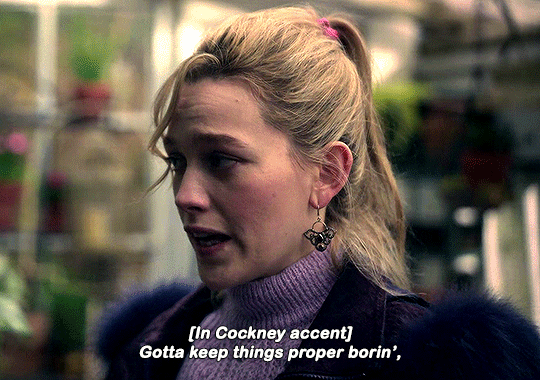
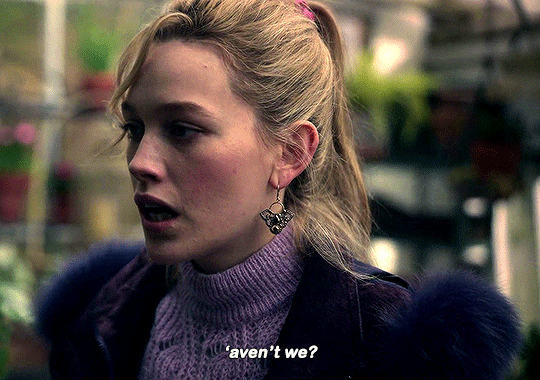

THE HAUNTING OF BLY MANOR
Episode 6: The Jolly Corner
#the haunting of bly manor#thobmedit#dani clayton#jamie#2x06#bm spoilers#*gifs#bbelcher#cinemapix#filmtv#userstream#userfreja#tusermadison#tuserdee#tuserlo#nessa007#by dana
2K notes
·
View notes
Text
The Haunting of Bly Manor: Episode Analysis
*SPOILERS*
Episode 2 - The Pupil
Episode 2 of The Haunting of Bly Manor is split into two halves, with the first being 6 months earlier and focusing on how and why Miles got sent home from boarding school; and the second half continuing with the present-day storyline at the manor.
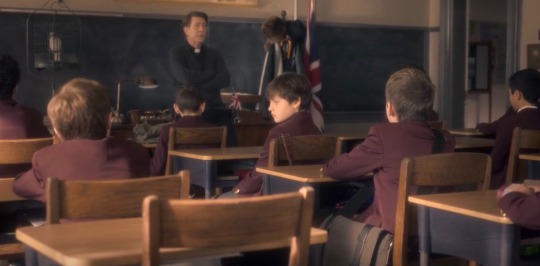
A teacher at Miles’ school, Father Stack, who takes a particular interest in helping Miles, reads a bible excerpt from Mark 5:11 in one of the lessons. He reads “now, there on the hillside a great herd of swine were feeding. And the unclean spirits begged him, ‘send us into the swine, let us enter them’. So, he gave them permission, and the unclean spirits came out and entered the swine. And the herd, numbering about two thousand, rushed down the steep bank into the sea, and were drowned in the lake”. The excerpt is important to Miles in regard to the rules for Peter and Rebecca taking over his and Flora’s bodies. According to this bible story, Miles is told that Peter and Rebecca cannot survive in his and Flora’s bodies without them being pushed out, unless Miles and Flora give “permission” for them to enter their bodies.
It’s a notable difference that the original bible excerpt says that they were drowned in the “sea”, not the “lake”. This alteration brings our attention the story, as it makes it more akin to Miles and Flora’s situation. It also brings it to Miles’ own attention that Peter and Rebecca taking over their bodies permanently will “drown” them, because they will never be able to take over their own bodies again. However, it also gives Miles hope that even the “demons” can’t take away man’s god given free will; and so Peter and Rebecca can’t take possession of their bodies permanently, without them being given the opportunity to use their own choice to grant them that permission.
Father Stack also calls the “unclean spirits”, which are parallel to Peter and Rebecca, “demons” when he is paraphrasing the story. The choice to change the word that’s used reflects Peter’s malicious intent of taking over Miles’ body.

On the blackboard behind Father Stack, we can also see that there is a number of other bible verses which the pupils are reading in class. We can see written on the blackboard is; Mark 5:1-20, Gerasene Demonica, Matthew 8:28-34, Luke 8:26-37 and Healing Gerasene Demonica. All of the verses on the board are various narratives of the Exorcism of the Gerasene Demonica, which is the name of the story that Father Stack was reading.

Miles then receives a letter from Flora, through Father Stack. We don’t find out until later in the episode that Flora’s letter says “come home”, and has a drawing of her crying with a sad Rebecca and a happy Peter near her. The “come home” that’s written on the letter is a nod to The Haunting of Hill House, where Olivia wrote on the wall for Nell to “come home” to her. In both of these instances ‘coming home’ results in tragedy. For Nell it resulted in her death and if Dani hadn’t saved Miles and Flora, then Peter and Miss Jessel would have succeeded in possessing their bodies.
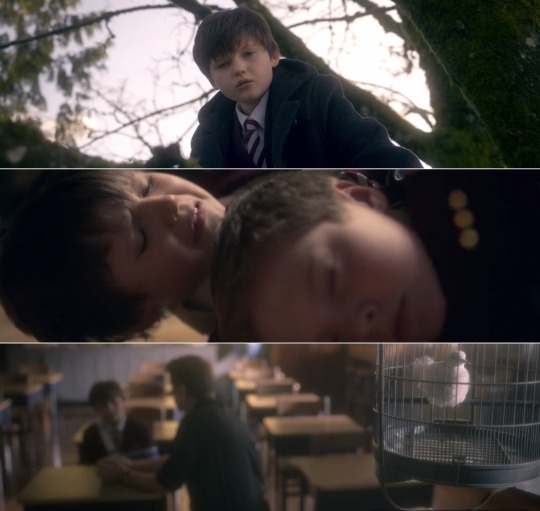
We then see Miles climb up a tree and jump from it. An action which seems odd and sudden at first, but after we find out that Miles is actually trying to get home after receiving Flora’s letter, it makes much more sense. Miles had heard at the beginning of the day that a classmate was at home and not able to return because “he took a bit of a tumble”, so Miles is also trying to get sent home by taking a “bit of a tumble” himself. However, his plan doesn’t succeed and so he acts out in a number of increasingly troubling ways in order to get sent home.
That evening, Miles’ friend, Hooper, asks him why he jumped from the tree and Miles says that he was “just looking for the right key”. Looking for “the right key” turns out to be something that Miles learnt from Peter. In Episode 3, Peter told Miles that to impress a woman you have to find the right key for her, and for the majority of women their ‘key’ is flowers. So in this instance, Miles’ goal is not to impress a woman but to return home to Flora, and so he is trying to find “the right key” to make Father Stack give up on him and send him back home.
Miles’ third and final attempt to get himself sent home was to kill Father Stack’s bird, called Pidge, and he then shows no remorse when asked to apologise for the act. Miles does this because Father Stack told him previously that “it’s that feeling of remorse, that guilt... that’s what distinguishes us in God’s eyes” and that “none of us are blameless except... the animals”, and so he knows that the only way that Father Stack will send him home is if he does something unforgivable against an “innocents” and shows no “guilt” for doing so.
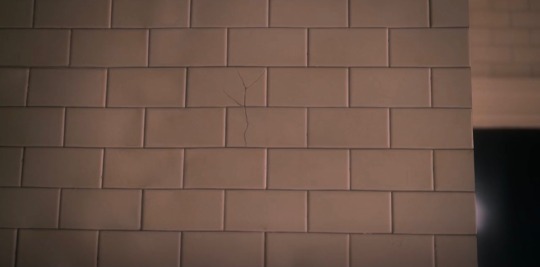
Back in the present day we see Hannah staring at a crack in the kitchen wall, which we go on to find out is actually a recurring vision of a crack in the well.’s wall. This crack in the wall of the well was the last thing that Hannah saw, after being pushed down the well, before she died.

As Owen, Hannah and Jamie sit and relax while Dani has the children weeding in the garden, they have a brief conversation. Jamie ‘tests the water’ and asks Owen his “thoughts on the new au pair” and says that she thinks that Dani is “maybe a bit too pretty”, continuing to ask him “do you think she’s pretty?”. Jamie is obviously interested in Dani but wants to dip her toe in the water before plunging in, to see if Owen will attempt to pursue Dani. But Owen says “don’t worry, I only have eyes for you, Hannah” - if Jamie knew that Owen, the only man in the manor, was interested in pursuing Dani then she knows that there would be no point in even attempting to pursue Dani herself. But through this probing she’s found out that she will have no competition from him, so she has a glimmer of hope that she might have a chance.
In this scene, Hannah also touches the back of her neck/head, which is something that she does repeatedly throughout the season. She constantly does this gesture because her neck was broken when she was pushed down the well; so she continually feels the pain in her neck, in the same way as she often sees cracks in the walls and gets stuck in memory loops.
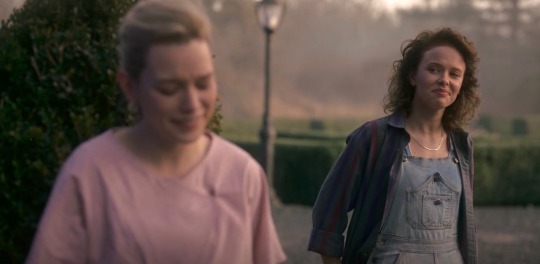
Later, after the children and Dani have finished the gardening, Dani returns to her room to find that Flora has cleaned it and has found Eddie’s glasses amongst her belongings. Dani runs out of the house and has a panic attack, as this is probably the first time that she’s seen the glasses since Eddie’s mother gave them to her right before she left for Europe.
Jamie is on her way to fill in the crack in the kitchen wall, which Hannah asked her to do earlier, when she comes across Dani as she’s having her panic. Jamie handles it in the best way possible by trying to get Dani to laugh. It’s clear that her goal was to make Dani laugh as when Dani does eventually laugh, she smiles and says “there we are”. Jamie continues to try to calm Dani down and to help her feel normal and not be embarrassed (we can clearly see Dani is embarrassed and trying to hide her crying), as she tells her “I cry three, maybe four ties a day around here. Five, if I’m really being honest with myself”.
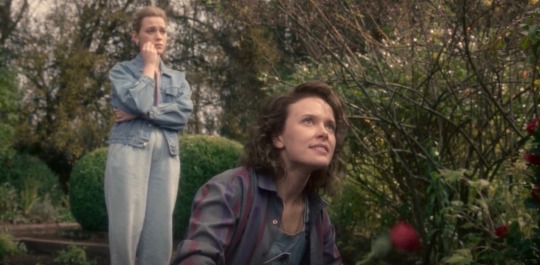
In return for helping to calm her down when she was having a panic attack, after finding that Miles (being possessed by Peter) has ruined Jamie’s roses, Dani tries to calm Jamie down. Although at first saying that they’re “just a few flowers”, after seeing how much Jamie cares about them, Dani instead is sympathetic and says “no, you’re right, I’ll talk to him”.
Just like Jamie did with Dani, Dani assesses the situation and adapts to fit the emotional need that was required of her at that moment - to calm Jamie down and make her feel seen. Dani shows compassion, empathy and understanding towards Jamie’s feelings, even though she might not understand why Jamie is upset herself.

When Dani is playing the game of hide and seek with Flora and Miles, Flora hides up in the attic. The attic is where the ghost of Perdita lives and that’s why the ghost can only hum along with Flora with a strained voice - Viola strangled Perdita, so her throat must have been extensively damaged and so she can only really wheeze.
Amusingly, after Miles (being possessed by Peter) tries to strangle Dani during the game of hide and seek, Dani says that the game is over, she runs back into the main part of the house and shouts “olly olly oxen free”. I’d never heard this term myself, but after looking it up, I found that it’s a phrase used to tell the players of a game that the sides have changed or that the game is over entirely. I found this amusing as it seems like a very feeble attempt to rein the children back in, after almost being strangled by one of them.

After seeing Peter through a window, we get the first example that what Dani said about herself in Episode 1, “I’m a lot braver than people think”, is definitely true. She doesn’t run and hide, despite being absolutely terrified of Peter, but she picks up a fire poker and runs outside, shouting “I’m going to call the fucking police”, to confront him herself.
At the end of the episode we get another example of Miles trying to protect Dani from the ghosts in the house. Miles knows that Peter is lurking around, as he’s just been possessing him, and so he tells Dani that he doesn’t “feel so good” and pretends to faint, so that Dani will come back inside and away from Peter.
You can read my previous The Haunting of Bly Manor posts here:-
Episode 1 - The Great Good Place
Episode 3 - The Two Faces, Part One
Episode 4 - The Way It Came
Episode 5 - The Altar of the Dead
Episode 6 - The Jolly Corner
——————————————————————————
#the haunting of Bly manor#mike flanagan#Victoria pedretti#oliver jackson cohen#amelia eve#t’nia miller#rahul kohli#carla gugino#tahirah sharif#henry Thomas#kate siegal#the haunting of hill house#dani x jamie#film#good tv#lgbtq#w|w#tv recommendations#tv reviews#horror#cinematography#dani clayton#thobm#thohh#thobm spoilers#reviews#gothic romance#you#peter x rebecca#owen x hannah
50 notes
·
View notes
Text
The Haunting of Bly Manor: Mike Flanagan Discusses Standout Eighth Episode
https://ift.tt/eA8V8J
The following contains spoilers for The Haunting of Bly Manor.
When developing Netflix’s 2018 horror hit The Haunting of Hill House, writer/director Mike Flanagan always intended to film an episode that flashed back to the history of the titular house and spent time with all the former inhabitants before the Crain family arrived. Unfortunately, things didn’t work out.
“We didn’t get to do it,” Flanagan says. “We’d written it, we’d cast it, we’d scheduled it. It got excised before we could shoot it as we struggled to try to get the season done on time and on budget. That was the thing that we sacrificed on the altar of good behavior.”
Turns out that sacrifice on the altar of good behavior would bless Flanagan’s Hill House followup, The Haunting of Bly Manor, with an opportunity to pull off the very same concept in a new context. The Haunting of Bly Manor episode 8, “The Romance of Certain Old Clothes” is a sprawling origin story, shot in gorgeous black and white. It tells the tale of the two rich sisters, Perdita (Katie Parker, who played the “flapper ghost” in Hill House) and Viola (Kate Siegel who is Flanagan’s wife and frequent creative collaborator) who are charged with keeping the estate afloat after the death of their father.
To that end, Viola marries the rich Arthur Lloyd but then she is struck with a lingering illness. Perdita eventually “mercy” kills her increasingly sick and increasingly cranky sister, which turns Viola into the powerful ghostly shade that will one day be known as The Lady of the Lake, whose gravity holds dominion over Bly Manor. Set as the penultimate episode of the season, “The Romance of Certain Old Ghosts” represents a brief pause in the action for some exposition, but is done so in a highly stylized way.
“That episode’s my favorite this season,” Flanagan says. “The idea that we could actually go back and tell the story of the haunting itself, and of the ghosts, so that they weren’t so hard to connect to our protagonists, that was really exciting. It also seemed like such a great opportunity for Kate and for Katie, both of whom we couldn’t find overarching series regular roles for in the story as it was structured.”
Like the rest of The Haunting of Bly Manor, episode eight was inspired by the work of Gothic horror writer Henry James. While this season borrows from novella The Turn of the Screw and short story “The Jolly Corner,” “The Romance of Old Ghosts” borrows much of its plot from a James yarn of the same name.
“Other than having, I think, the best title of any short ghost story I’ve ever heard, (it has) the seeds of so many things that have become embedded in contemporary horror. You read the story as it is, and you can see the inspirations for The Ring and for The Grudge,” Flanagan says.
Both the television and short story versions of “The Romance of Certain Old Clothes” feature the shocking moment in which one sister enacts ghostly revenge on the other, though the names and roles of the sisters are switched. In the Bly Manor version, it is Violet who makes Arthur promise to lock away her treasured clothing in a chest and to save it for when their daughter comes of age. When Perdita decides to open the chest for herself it leads to the biggest jump scare of both iterations.
“It’s so beautifully described in the book that they find the poor woman splayed out in front of the trunk with this frozen expression of horror on her face, and the bruises of the fingers around her neck from the ghost that strangled her,” Flanagan says.
“That is more aggressive and vicious than anything else Henry James ever wrote about a ghost. Most of his ghosts are incredibly polite, and they just kind of are like, ‘Oh, hello.’ But to me, it really shows how some of the ideas Henry James first put out there have caught on either consciously or subconsciously over the years, and have continued to inform the genre. That story was always going to be one of the crown jewels of the season.”
Though Flanagan began as and remains primarily a director of horror films, with The Haunting franchise he has proven he has a strong handle on what makes episodic storytelling on television work as well. The standout nature of “The Romance of Old Clothes” is reminiscent of Hill House’s episode 6 “Two Storms,” the experimental lynchpin of that season which features long tracking shots and deftly moves between two timeframes. According to the director, it was important for Bly Manor to have a standalone episode that matched the energy and import of “Two Storms.” But doing so came along with a new set of challenges.
“It was one of those episodes, much like episode six in season one, that we were preparing for and building up to the entire time,” Flanagan says. “We shot it last. We had finished our ‘A’ story and made it all the way to the end. And then we had to redress everything – the interior of the house, the exterior of the house. We got rid of all the electric light fixtures, put in all the candle sconces, completely changed everything over. (Then we) got to finish the experience of making the season with this beautiful standalone, truly Gothic romantic black and white period piece.”
Though Flanagan oversees all aspects of Bly Manor as showrunner, he directed only the first episode this time around rather than directing all installments like on Hill House. He describes the experience of directing 10 episodes of Hill House as so intense that he came out of it “a shell of (himself)”, having lost 40 pounds. Several directors take over the reigns for Bly Manor and it’s Belgian director Axelle Carolyn (Soulmate) who handles duties on episode 8.
“Axelle Carolyn is a student of classic black and white horror cinema, and came to it with so many exciting ideas of how she wanted to tell it,” Flanagan says. “Everybody was always looking at episode eight as our chance to do what we love the most and what made us want to do The Haunting at all, which is to look back at Robert Wise and Jack Clayton and those incredibly influential movies from the early ’60s. They were done so perfectly, they’ve rendered it pointless to try to do a faithful feature adaptation of these texts.”
The Haunting of Bly Manor is certainly no stranger to interesting adaptation choices and horror homages. Inspiration from Flanagan’s horror influences and Henry James’s classic texts are readily evident across the entirety of the season. “The Romance of Certain Old Clothes” is just arguably where they all come together the most effectively. And if nothing else, episode eight is where ghosts of The Haunting world finally get the origin story they so richly deserve.
cnx.cmd.push(function() { cnx({ playerId: "106e33c0-3911-473c-b599-b1426db57530", }).render("0270c398a82f44f49c23c16122516796"); });
The Haunting of Bly Manor is available to stream on Netflix now.
The post The Haunting of Bly Manor: Mike Flanagan Discusses Standout Eighth Episode appeared first on Den of Geek.
from Den of Geek https://ift.tt/36YtuIL
0 notes
Text
How The Haunting of Bly Manor Adapts The Turn of the Screw and Other Henry James Works
https://ift.tt/3loTz7C
The following contains spoilers for every episode of The Haunting of Bly Manor.
Henry James (probably known as Hank Jim to his friends) is one of the most prominent and prolific writers of his era. Originally appreciated for his novels like The Portrait of a Lady and The Ambassadors, James is now best-known for his 1898 work The Turn of the Screw, an eerie, ambiguous ghost story novella that would become one of the most enduring Gothic horror texts ever.
The Turn of the Screw has been adapted dozens of times into films, operas, ballets, and more. And James’s classic story forms the basis for Netflix’s Haunting of Hill House follow up The Haunting of Bly Manor. Just as Hill House uses Shirley Jackson’s horror story as a jumping off point, so too does Bly Manor liberally borrow from The Turn of the Screw. But that’s not where the Henry James party ends for this series. The Haunting of Bly Manor puts several other Henry James stories to good use as well.
The Turn of the Screw, and short stories “The Jolly Corner”, and “The Romance of Certain Old Clothes” all play crucial roles in building the spooky tale that showrunner Mike Flanagan is out to tell this time around. And here is a helpful breakdown of what each James story brings to the proceedings.
The Turn of the Screw
Given that this is the Hill House/Bly Manor franchise, perhaps it’s helpful to use housing terminology to discuss The Turn of the Screw’s contributions to the series. The Turn of the Screw makes up the foundation of The Haunting of Bly Manor. Hell, it might just make up the walls and roof as well for as the show takes just about every base level detail from James’s seminal work.
The Turn of the Screw opens up as a frame story. A group of Victorian-era aristocrats has gathered together to share ghost stories with one another Mary Shelley-style. One guest has a story that is sure to blow everyone else away and begins to tell it to the enraptured audience. Bly Manor borrows this frame story technique but replaces the unnamed aristocrat with Carla Gugino’s character (who is later revealed to be Jamie) sharing a story at a wedding.
Read more
TV
The Haunting of Bly Manor Review (Spoiler-Free)
By Nick Harley
Once both the novella and the show’s narrators launch into their stories, we can see that there are plenty of similarities. The Turn of the Screw deals with an unnamed Governess (a fancy British word for a live-in schoolteacher at a mansion) who gets a job teaching two children at an English countryside manor following the deaths of their parents. Though the Governess (a.k.a. Victoria Pedretti’s Dani) doesn’t get a name in the novella, all the other names are the same. The children are Miles (Benjamin Evan Ainsworth) and Flora (Amelie Bea Smith) and their caretaker is Mrs. Grose (T’Nia Miller). And then when the spooky stuff hits the fan it’s revealed that the kids’ previous governess was named Miss Jessel (Rebecca Jessel in the show, played by Tahirah Sharif) and she had a close relationship with another one of the estate’s employees, Peter Quint (Oliver Jackson-Cohen). In terms of characters, the only major additions for the show are Amelia Eve as the gardener Jamie and Rahul Kohli as chef Owen.
As the story progresses, it’s clear that The Haunting of Bly Manor intends to stick closer to The Turn of the Screw than The Haunting of Hill House did with its namesake. There is something clearly off with Miles and Flora and it likely has to do with the dead Peter Quint and Miss Jessel. The Governess repeatedly sees the shade of Peter Quint on the grounds of the manor just like Dani does in the show. Miles acts out at his boarding school and is sent home early. Flora one night even gets out of bed and wanders out to the lake on the property where the Governess is convinced she is communing with the ghost of Miss Jessel.
Beginning around episode 6, The Haunting of Bly Manor begins to deviate from The Turn of the Screw’s plot and eventually concludes with a wildly different ending. That’s partly because The Turn of the Screw doesn’t have much of an ending (what is it with Gothic writers and their penchant for having people randomly drop dead) but also because the show is drawing from two other Henry James sources.
The Jolly Corner
Episode 6 of The Haunting of Bly Manor is called “The Jolly Corner” for a reason. This is the hour in which we catch up fully with Henry Wingrave (Henry Thomas), the current owner and executor of Bly Manor, who is wracked with guilt over an affair he had with his brother’s wife before their deaths.
That guilt eventually takes on a metaphysical component as Henry is quite literally haunted by the worst version of himself. The evil version of Henry continually taunts the “normal” one each night, reminding him of all his mistakes and misdeeds. Whether this is a hallucination or some kind of evil shade is left deliberately vague. But the arrival of the second Henry is preceded by the last words Henry’s brother ever spoke to him: “I pity you because you have to live with him. You have to live with yourself.”
Ouch.
“The Jolly Corner” borrows its name from a Henry James short story, which features a similar doppelganger phenomenon but in a vastly different context. The story follows Spencer Brydon, a man who returns to his childhood New York home on the “jolly corner” after decades spent abroad.
Spencer gets to work renovating his childhood home and comes to find that he has a real knack for it. He’s so good at it in fact that he begins to wonder what his life would have been like if he had stayed in the U.S. and dedicated his career to the construction business. This thought quickly turns into delusion as he imagines that he is being haunted by the version of himself who truly did stay behind in the U.S. and put his talents to good use. Spencer finally confronts the ghost of himself and in the true Henry James-style promptly dies…or does he?
The Romance of Certain Old Clothes
While “The Jolly Corner” makes up an exceedingly small portion of The Haunting of Bly Manor, the final Henry James contribution, “The Romance of Certain Old Clothes” is of enormous significance to the show’s plot. Going back to our housing metaphor, if The Turn of the Screw is the foundation of Bly Manor, then “The Romance of Certain Old Clothes” is nothing less than the people inside the home. The plot of this short story is crucial to understanding the context of what’s really happening at Bly Manor.
First, an abbreviated summary of the short story. “The Romance of Certain Old Clothes” is set in 18th century Massachusetts. It follows two daughters in the aristocratic Wingrave family: Viola and Perdita. Both Viola and Perdita fall in love with rich suitor Mr. Arthur Lloyd and Arthur eventually chooses to marry Perdita. Despite promises not to get jealous…Viola gets pretty jealous. The sisters’ relationship becomes strained and only worsens when Perdita falls ill.
As Perdita slowly dies, she makes Arthur promise to hide away her beloved gown in a chest so that her daughter can have it once she comes of age. Arthur does so and Perdita dies. The Lloyd and Wingrave estate then begins to crumble due to Arthur’s mismanagement. Viola urges Arthur to open the chest either for herself or to sell off its contents. When Arthur refuses, Viola takes matters into her own hands and heads up to open the chest herself. Arthur later heads up to find Viola on her knees and dead, with wounds visible from ghostly hands.
If all of this sounds familiar, that’s because it is almost the exact plot of The Haunting of Bly Manor episode 8. The only major change at the outset is the switching of the roles of Viola and Perdita. In the show it is Perdita who is killed by a ghostly Viola. Then Mike Flanagan and the series take the story a step further and imagines what would happen after Perdita’s death.
Viola “lives” on as a ghost inside the chest. It’s not until Arthur disposes of the chest in the lake on the grounds that Viola is eventually freed. But even then hers is a sad afterlife. She resides under the water by day before coming out at night and prowling the grounds in search of…well, she’s never quite sure what. Over time, whatever was left of Viola’s appearance and personality begins to fade. She becomes the faceless Lady in the Lake and her stubbornness creates a “gravity” at Bly Manor so all who die there stay on as ghosts.
It’s the Lady in the Lake who kills Peter Quint, seemingly only for the crime of him being out and about at night in her house. And just like that The Haunting of Bly Manor ties one of Henry James’s more obscure ghost stories into his most famous one in The Turn of the Screw.
cnx.cmd.push(function() { cnx({ playerId: "106e33c0-3911-473c-b599-b1426db57530", }).render("0270c398a82f44f49c23c16122516796"); });
Many properties have tried their hand at The Turn of the Screw, but none of them until now have thought to tie in the ghost from “Certain Old Clothes” as the gravity of it all. Not a bad day’s work for The Haunting franchise.
The Haunting of Bly Manor is streaming now on Netflix.
The post How The Haunting of Bly Manor Adapts The Turn of the Screw and Other Henry James Works appeared first on Den of Geek.
from Den of Geek https://ift.tt/3lrFG8Q
1 note
·
View note